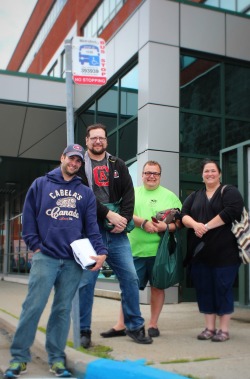'Help is here'

Four high school teachers and principals from Labrador aimed to experience Memorial through the eyes of a new student from an Aboriginal community last month.
Recognizing the importance of developing relationships with Aboriginal students on the coast of Labrador well before they arrive at the St. John’s campus, Memorial’s Aboriginal Resource Office (ARO) initiated a two-year pilot project.
Beginning with the week-long familiarization tour for high school teachers and principals from the northern coast of Labrador, the project will provide several opportunities to engage both high school students and teachers through site visits and ongoing contact throughout the school year.
For four days, Dion Rideout visited from J.C. Erhardt Memorial in Makkovik; Tom Mugford came to Memorial from Northern Lights Academy in Rigolet; Curtis Oliver visited from Amos Comenius Memorial School in Hopedale; and Juanita Skanes visited from Jens Haven Memorial School in Nain.
The intrepid visitors lived in Macpherson College, attended classes, rode the Metrobus, visited the Marine Institute, interacted with a simulation at the Faculty of Medicine, met with members of the Aboriginal Resource Office and visited community partners at the St. John’s Native Friendship Centre.
The group was especially impressed with simulations at the Faculty of Medicine and the Marine Institute, the resources available at Answers and the University Centre, and they also enjoyed visiting the Native Friendship Centre.
“They have amazing staff,” said Mr. Oliver. “They help people become a part of the community, feel welcome and that they belong. Aboriginal students have a piece of home in the city.”
“This week exceeded my expectations,” said Mr. Rideout. “It opened my eyes to the supports that are available. The most important thing we’re seeing is that for new students coming in, the support is there. They are not alone. They don’t need to feel overwhelmed. Help is here.”
The familiarization visit is one step toward helping ease students’ transitions from remote Labrador communities to Memorial’s St. John’s campus and Marine Institute. To offer a sense of scale, Mr. Rideout shared that his school in Makkovik has 65 students from kindergarten to Grade 12. With a student population of 18,000, Memorial is far larger than anything these high school students have been accustomed to in their everyday lives.
“One of the biggest challenges for an Aboriginal student from the north coast of Labrador is the culture shock,” said Mr. Rideout. “Coming into a large city and a large university like this can certainly be daunting. If we can come up with a way to familiarize students with the city, the campus, the programming – just to make life easier for them. That is the most important goal.”
Along with the culture shock that may come with encountering new surroundings and a much larger population, students from remote communities may also feel overwhelmed by stark differences in transportation, pace and lifestyle in St. John’s, as well as the class sizes, teaching styles and academic demands at university.
Upon return to their respective North Coast communities, thee teachers will assist in developing and executing a series of outreach sessions to their students during the 2015-16 academic year. The final phase of the pilot program will take place in summer 2016, and will include a familiarization tour for 14 high school students who will attend a five-day “Junior University.”
Sonya Clarke Casey, Aboriginal liaison officer, and Sheila Freake, Aboriginal Resource Office co-ordinator, are leading the new program.
“When the teachers go back to their schools on the North Coast, I hope they will feel completely comfortable picking up the phone and saying, ‘Sonya, I have a question for you about …,’” said Ms. Clarke Casey. “When that happens, I know we have begun paving the road for our Aboriginal students from Nunatsiavut. Relationship building is key.”
Ms. Freake hopes the program will result in building positive relationships with schools and communities in northern Labrador.
“Hopefully, this project will also result in improved communication and collaboration within Nunatsiavut which will increase recruitment and retention of Aboriginal students at Memorial,” she said. “I was glad to see the passion that the teachers had coming in ―people who volunteered their time over their summer holidays ― they are very passionate about, and interested in, their work,” said Ms. Freake. “I have no doubt that they will go back to their communities and talk about the supports we have available here. I’m very pleased with their energy and their interest.”
Mr. Oliver expressed his excitement to return to Hopedale and share his experience with students.
“I want to let them know that there is so much offered at the university – so much more than I ever imagined. This week made me want to be a student again. If a student is unsure of what to do or where to go, all they need to do is go to the University Centre and speak to someone at Answers or the ARO and they are there to help them.”
Mr. Mugford was impressed with the resources available on campus.
“There are resources here for students, and it’s not too far from home. There are people here who will help to ensure your time here is successful and that you are successful.”
For more information about the Aboriginal Resource Office’s programs, please visit mun.ca/aro.